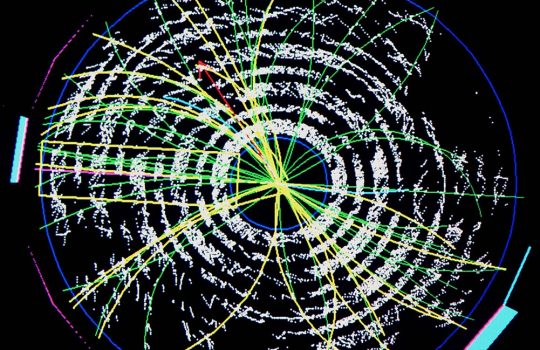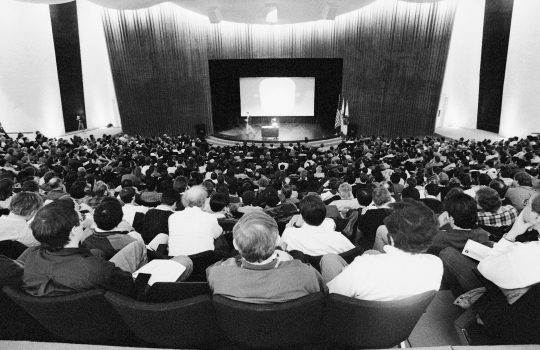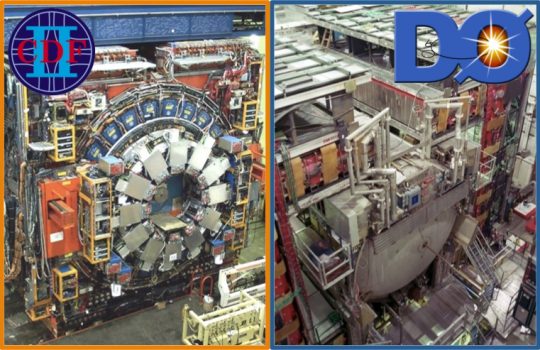Batavia, Ill.— Scientists from the Department of Energy’s Fermi National Accelerator Laboratory announced today (July 25) that for the first time they have made data collected by a high-energy physics experiment available to any scientist who wants to use it.
University of Chicago physicist Bruce Knuteson, a Fermilab scientist and former member of the DZero experiment collaboration, has developed a World-Wide-Web-based computer tool to allow physicists worldwide to search the experiment’s data. With the help of DZero colleagues, Knuteson created the new tool, called Quaero (Latin for “I search”; http://quaero.fnal.gov), to provide access to data collected from 1992 to 1996 by the DZero detector during Collider Run I at Fermilab’s Tevatron, the world’s most powerful particle accelerator.
The new tool, whose description DZero has submitted for publication to the journal Physical Review Letters, enables physicists outside the DZero collaboration to perform their own computerized data searches for evidence of new physics. Without the Quaero interface, the data would be impossible to interpret by physicists outside the collaboration.
“Until now,” said DZero spokesman John Womersley, “a proper analysis of our experiment’s data has required a detailed understanding of the nuances and idiosyncracies of each of thousands of components of our 5,000-ton detector. The unique characteristics and quirks of the detector influence the interpretation of the data, making it usable only to initiates within the collaboration. Quaero incorporates the experimenters’ intimate knowledge of the detector, allowing meaningful use of our data by other physicists.”
Collaboration scientists use sophisticated data-analysis tools to search terabytes of data from trillions of high-energy proton-antiproton collisions recorded by the DZero detector. The data made public via Quaero include samples that led to the discovery of the top quark at DZero. The top quark, a fundamental building block of matter, was discovered in 1995 by Fermilab’s DZero and CDF experiments. Quaero does not provide access to data currently being recorded at Tevatron Run II experiments.
Quaero marks the first time a high-energy collider physics collaboration has made its experimental data available through an easy-access Web-based interface to scientists and students from universities and laboratories outside the experiment. Fermilab Director Michael Witherell welcomed the initiative to share the benefits of the investment in DZero beyond the collaboration’s membership.
“DZero represents not only the investment of millions of dollars,” Witherell said, “but also an enormous intellectual effort and thousands of person-years of hard work. We need to make the greatest possible use of this investment and of the information it gives us about the way nature works. Quaero takes a big step toward this goal.”
DZero collaborator Greg Landsberg, a physicist from Brown University, said that Quaero represents an extension of the original idea behind the World Wide Web, developed in 1991 at CERN, the European Laboratory for Particle Physics, to facilitate high-speed communication among high-energy physicists around the globe.
“Quaero is an experiment to try to take this original idea one step further in making particle physics data available to scientists worldwide,” Landsberg said. “If it works, it will be a big leap forward for our collaboration and for the high-energy physics community as we make the results of the tremendous investment in DZero available to all physicists.”
While Quaero is designed for use by professional physicists, other efforts are underway to provide access to experiments for more general audiences. The QuarkNet program (http://quarknet.fnal.gov), for example, involves high-school students and teachers in ongoing particle physics experiments at Fermilab and CERN. The Fermilab website offers real-time views of Tevatron Run II particle collisions as they happen at the CDF and DZero detectors (http://www.fnal.gov/pub/inquiring/live_events/index.html).
Scientists at other high-energy physics laboratories have expressed interest in further applications of Quaero.
“Quaero is taking a very interesting direction,” said Stanford Linear Accelerator Center Director Jonathan Dorfan. “It may well point the way for other experiments beyond DZero.”
Next month, Knuteson will travel to CERN, the European Particle Physics Laboratory near Geneva, Switzerland, to explore the potential for adapting Quaero for use at CERN experiments.
Fermilab is operated by Universities Research Association, Inc. under a contract with the U.S. Department of Energy.



